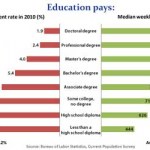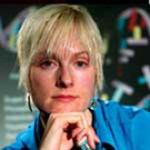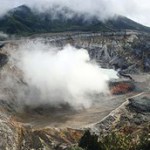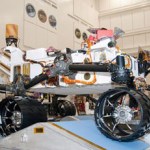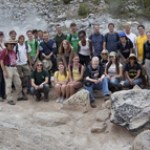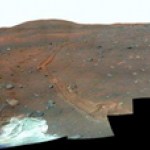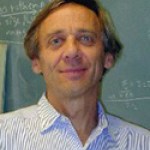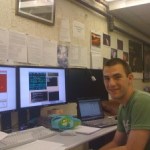SETI Institute
By Dr. Gerry Harp, Senior Astrophysicist, Center for SETI Research, SETI Institute, and Gail Jacobs
Trained as a quantum mechanic, Dr. Gerry Harp was deeply interested in possibilities for using the multiple telescopes of the Allen Telescope Array to generate steerable "beams" on the sky -- beams that could be far smaller than any single antenna could produce. Such beams don't emit anything, but work in reverse by capturing only energy that comes from the sky in a certain direction. Gerry joined the SETI Institute in 2000, practically at the telescope's inception and uses the telescope for…
By Dr. Cynthia Phillips
Planetary geologist at the Carl Sagan Center for the Study of Life in the Universe, SETI Institute
The final mission of Space Shuttle Atlantis has spawned a whole series of perspective pieces on the history, state, and future of space exploration. Some, like the YouTube video "NASA's increase of awesome to continue," are unabashedly exuberant celebrations of the future in store for us in space; others, like this thoughtful piece in Technology Review entitled "Was the Space Shuttle a Mistake?," are depressingly and effectively critical of the cost both in dollars (more…
Remembering Dr. Emma Bakes
An exceptional person, Dr. Emma Bakes passed away on February 28, 2011. She accomplished a great deal and touched many people in an unfortunately short time. Her accomplishments span oceans and included the physical sciences, medicine, fashion, martial arts, and parenthood to name just a few. To honor and remember her, the SETI Institute and NASA's Kepler Mission Team invite you to read the following essay she wrote just a few months ago. It is an essay that reflects her life and her legacy...Donald Mendoza, NASA Ames, and the SETI Institute
The Shore of the Cosmic…
By Dr. Ignacio Mosqueira, an astrophysicist at the Carl Sagan Center for the Study of Life in the Universe, SETI Institute, and Gail Jacobs
Ignacio Mosqueira works with Paul Estrada to piece together the way in which giant planets - such as Jupiter and Saturn -- and their moons and rings formed. Ignacio notes that making moons is similar to forming planets. Understanding moons may have something to tell us about the possible habitats for life, since large moons could, in principle, have both the liquid water and atmosphere necessary for the kind of diverse biology we see on planet Earth.…
By Dr. Rosalba Bonaccorsi
Environmental Scientist at the Carl Sagan Center for the Study of Life in the Universe, SETI Institute, and Gail Jacobs
Rosalba, what first sparked your interest in science?
I've always had big dreams -- even as a young girl. As soon as I started to walk, I took an interest in conducting experiments with whatever was available around such as household plants and various chemical compounds. I'm lucky I didn't end up poisoned or otherwise hurt! I remember dismantling alarm clocks. I was so curious!
As a young girl, I was in poor health and as a result spent a lot of…
By Dr. Mark R. Showalter
Planetary astronomer at the Carl Sagan Center for the Study of Life in the Universe, SETI Institute
It was just a few months ago that Stephen Hawking was making headlines with his bold assertion that extraterrestrial beings, if they exist, are best avoided. His argument was based in part upon the fact that the arrival of Christopher Columbus to the "New World" didn't work out so well for the Native Americans who were already here. However, upon closer inspection, Hawking's ideas fell apart. Even if nomadic tribes of ETs are really out there looking for a handy source…
Every summer, the SETI Institute hosts 15-20 college students from around the country as part of its Astrobiology Research Experience for Undergraduates (REU) internship program. The program, which is funded by the National Science Foundation and the NASA Astrobiology Institute, pairs each student with a research mentor at the SETI Institute. At the end of the 10-week internship, each student presents a talk and written report on their research project, and many students go on to present their work at professional conferences during the following academic year.
This year, our 19 REU interns…
By Dr. Adrian Brown
Planetary Research Scientist at the Carl Sagan Center for the Study of Life in the Universe, SETI Institute
The last two months have witnessed several extremely important events with respect to future Mars Exploration. The first two revolved around the rover "Spirit." The other two are a new mission to Mars and a possible road for humans to Mars.
"Spirit"
On June 3rd, the Mars Exploration Rover (MER) team published a stunning paper describing how the rover "Spirit," now immobile in the shifting sands of Gusev Crater, detected carbonate minerals in a rock called "Comanche…
Don Backer, an astrophysicist at the University of California, Berkeley who discovered the first millisecond pulsar, died on July 25. He was director of Berkeley's Radio Astronomy Laboratory and the Allen Telescope Array (ATA) in Hat Creek, California - a collection of 42 dishes that recently began scanning the sky and searching for extraterrestrial intelligence.
"Memories of a special moment with Don Backer"
By Jill Tarter
Don and I had only a few glancing interactions from the time we were engineering physics students at Cornell until one memorable day in 1982. On that day I pulled my…
By Dr. Franck MarchisPlanetary Astronomer at the Carl Sagan Center for the Study of Life in the Universe, SETI Institute
I mentioned in my previous post that we observed several known multiple asteroid systems during our last observing run with the W.M. Keck Observatory and its Adaptive Optics Systems. If you have been following my personal blogs and/or the scientific articles of our group (you are courageous...) you know this is the scientific topic which is taking most of my time recently. Today, as you can see if you explore our VOBAD database, we know 192 companions of asteroids. What I…
By Dr. Franck MarchisPlanetary Astronomer at the Carl Sagan Center for the Study of Life in the Universe, SETI Institute
I'd like to share the first of two blogs on observations of Io that we did using the Keck telescope and its Adaptive Optics (AO) system.
Similar to last year, my summer is busy with the REU (Research Experience for Undergraduates) students of the SETI Institute. I will write a specific post on two students who are working with me and their project in a few days.
I obtained telescope time at the end of June 2010 with the W.M. Keck II telescope and its Adaptive Optics system…
By Dr. Mark R. ShowalterPlanetary Astronomer at the Carl Sagan Center for the Study of Life in the Universe, SETI Institute
In 1609, Galileo introduced to the world his new invention, the astronomical telescope. It opened up new opportunities to explore a territory that all prior generations had regarded as familiar--the night sky. In short order, he was making major discoveries. But the sky is very big and Galileo's telescope was very small. He had to choose his targets carefully.
In that context, Saturn was nothing special, the least of the known planets, just a bright point in a black sky…
By Dr. Cynthia Phillips
Planetary geologist at the Carl Sagan Center for the Study of Life in the Universe, SETI Institute
Jupiter's moon Europa could be the best place beyond the Earth to search for life. This small moon, about the size of Earth's Moon, is one of the Galilean moons first discovered 400 years ago by Galileo. The Galilean moons were the first objects observed to orbit another planet, and they revolutionized the way our solar system was understood.
Today, the moons of Jupiter are known to be a scientifically rich part of our solar system, and they are yielding a new revolution…
by Nathalie A. Cabrol
I realize how immodest the title of this first blog may sound and it is certainly not my intention to convince anybody that I will answer this question in the limited space allowed here or even in a lifetime. My hope is, instead, to stir thoughts and invite an exchange of diverse perspectives to make this a thread that we can all pull from time to time. It is an immense subject debated in an abundant literature, but discussing it is certainly not the exclusive privilege of those called explorers. All beings, from the greatest minds to the simplest forms of life on this…
by Nathalie A. Cabrol
I realize how immodest the title of this first blog may sound and it is certainly not my intention to convince anybody that I will answer this question in the limited space allowed here or even in a lifetime. My hope is, instead, to stir thoughts and invite an exchange of diverse perspectives to make this a thread that we can all pull from time to time. It is an immense subject debated in an abundant literature, but discussing it is certainly not the exclusive privilege of those called explorers. All beings, from the greatest minds to the simplest forms of life on this…
